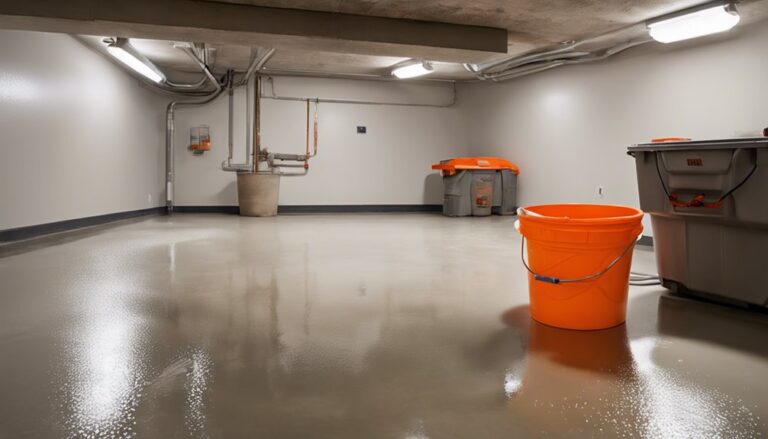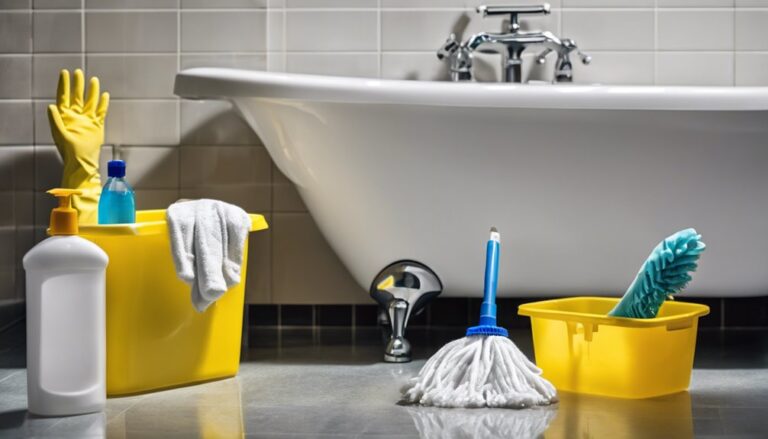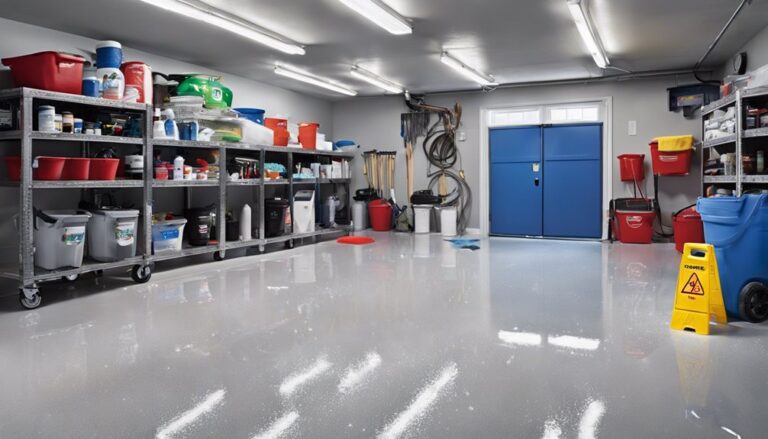To clean ceramic tile floors effectively, start by gathering your supplies: a mop, bucket, microfiber cloths, and a pH-balanced cleaner. Sweep or vacuum the floor to remove loose dirt. Prepare your cleaning solution and damp mop the tiles, ensuring to rinse the mop frequently to avoid spreading grime. For stubborn stains or grout lines, use a stiff-bristled brush or an old toothbrush. After mopping, rinse the floor with clean water and dry it as necessary. Establish a regular cleaning schedule to maintain your floors, and you'll discover more techniques for ideal care along the way.
Gather Your Cleaning Supplies
Before you begin cleaning your ceramic tile floors, it's essential to gather your cleaning supplies. Start with necessary supplies like a mop, bucket, and a pH-balanced tile cleaner. These cleaning tools will help you achieve a spotless finish without damaging your tiles. Don't forget microfiber cloths or sponges for wiping down stubborn spots. If you have grout lines that need special attention, consider a stiff-bristled brush.
For those hard-to-reach areas, an old toothbrush can be handy. Make sure you also have rubber gloves to protect your hands while you work. Having all these cleaning tools ready before you start will not only streamline the process but also give you the freedom to focus on achieving a gleaming floor.
Sweep or Vacuum the Floor
Once you've gathered your cleaning supplies, the next step is to sweep or vacuum the floor to remove loose dirt and debris. If you're sweeping, use long, even strokes, and focus on corners and edges where dirt tends to accumulate. A dustpan with a rubber edge can help capture more debris. For vacuuming, make certain you're using a vacuum designed for hard floors to avoid scratches. Employ vacuuming tips like using a low suction setting and moving slowly to effectively lift dust and particles. Pay attention to high-traffic areas, as they often require more thorough cleaning. This initial step sets the stage for a deeper clean, allowing your ceramic tile floors to shine.
Prepare the Cleaning Solution
To prepare an effective cleaning solution for your ceramic tile floors, start by choosing the right cleaner that suits your specific needs. Next, mix the ingredients according to the instructions to guarantee maximum effectiveness while preventing damage to your tiles. Finally, always test the solution on a small, inconspicuous area to confirm it won't adversely affect the surface.
Choosing the Right Cleaner
How can you guarantee that your ceramic tile floors shine without damage? Choosing the right cleaner is essential. Start by exploring different ceramic cleaner types, like pH-neutral solutions specifically designed for tile. These products effectively lift dirt without harming the glaze. If you prefer a more eco-friendly approach, consider natural alternatives, such as a mixture of vinegar and water. This can effectively clean your tiles while being gentle on the environment. Remember, harsh chemicals can erode your tiles over time, so always check labels for compatibility with ceramic surfaces. Ultimately, the cleaner you select should enhance your floors' shine while ensuring they remain intact, allowing you to enjoy your space freely and beautifully.
Mixing Ingredients Properly
Before you start cleaning your ceramic tile floors, it's crucial to mix your cleaning solution properly to guarantee the best results. Getting the mixing ratios right guarantees ingredient compatibility, maximizing cleaning effectiveness while protecting your tiles.
| Ingredient | Mixing Ratio |
|---|---|
| Water | 4 parts |
| Vinegar | 1 part |
| Mild Dish Soap | 1 teaspoon |
| Baking Soda | 1 tablespoon |
Follow this table as a guide to create your cleaning solution. Combine the ingredients in a bucket and stir gently to avoid excessive bubbles. Confirm each component is compatible with your tiles to prevent damage. With the right mixture, you'll be prepared to tackle dirt and grime effectively. Enjoy the freedom of a clean, sparkling floor!
Testing on Surfaces
Testing your cleaning solution on a small, inconspicuous area of your ceramic tile floor is essential to verify compatibility and avoid any adverse reactions. By doing this, you can guarantee your cleaning method won't compromise the surface compatibility or tile durability. Here's how to proceed:
- Choose a hidden spot, like behind a couch or near the baseboard.
- Apply a small amount of your cleaning solution and wait for a few minutes.
- Check for any discoloration, damage, or residue.
This methodical approach not only safeguards your tiles but also empowers you to maintain their aesthetic appeal. Remember, taking this extra step can save you from costly repairs and keep your ceramic floors looking pristine.
Mop the Ceramic Tiles
Mopping the ceramic tiles is an essential step in maintaining their shine and cleanliness. To achieve the best results, choose appropriate mop techniques and mop materials. Here's a quick guide to help you select the right tools and methods for your ceramic tile floors:
| Mop Technique | Mop Material |
|---|---|
| Damp mopping | Microfiber mop |
| Dry mopping | Dust mop |
| Steam cleaning | Steam mop |
| Spot cleaning | Sponge mop |
| Wet mopping | Cotton string mop |
Start by sweeping or vacuuming the floor to remove debris. Then, use a damp microfiber mop with a gentle cleaning solution. This method not only lifts dirt but also enhances the tile's shine, giving you that desired freedom from grime.
Address Stains and Grout
While keeping your ceramic tile floors clean is vital, addressing stains and grout can be equally important for maintaining their overall appearance. Stain removal is essential, as it prevents discoloration and damage. To effectively tackle stains and guarantee proper grout maintenance, consider these steps:
- Identify the type of stain for targeted removal methods.
- Use a gentle but effective cleaning solution, like a vinegar-water mix or a specialized tile cleaner.
- Scrub grout lines with a soft brush to lift dirt without causing damage.
Rinse and Dry the Floor
After thoroughly cleaning your ceramic tile floors, it's crucial to rinse and dry them properly to prevent any residue buildup. Start with a final rinse using clean water; this removes any leftover cleaning solution that could dull the finish. Use a mop or a soft cloth to apply the water evenly across the surface. Once you've rinsed the entire area, it's time for effective floor drying. You can either air dry the tiles or use a dry mop to speed up the process. If you choose to air dry, make sure proper ventilation in the room to help evaporate moisture quickly. Remember, a well-dried floor not only looks better but also reduces slip hazards and prolongs the life of your tiles.
Maintain Regular Cleaning Schedule
Once your ceramic tile floors are clean and dry, maintaining their appearance and durability requires a consistent cleaning schedule. Establishing a maintenance routine is essential for keeping your floors looking their best. Aim for a cleaning frequency that suits your lifestyle and the traffic your floors endure. Here are some recommendations:
- Weekly: Sweep or vacuum to remove dirt and debris.
- Bi-weekly: Mop with a gentle cleaner to tackle stains and dirt buildup.
- Monthly: Inspect grout lines and apply a sealer if necessary.
Tips for Long-Term Care
To guarantee your ceramic tile floors remain in peak condition, establishing a regular sweeping schedule is essential. Additionally, using pH-neutral cleaners will help prevent damage and maintain the integrity of the tiles. By following these guidelines, you'll extend the life and appearance of your floors considerably.
Regular Sweeping Schedule
A consistent sweeping schedule is essential for maintaining the beauty and longevity of your ceramic tile floors. Establishing a routine for daily maintenance helps prevent dirt and debris from accumulating, which can scratch and dull the surface. The cleaning frequency should align with your household's activity level.
Here are some tips to contemplate:
- Sweep high-traffic areas daily to eliminate buildup.
- Use a soft-bristle broom or a microfiber sweeper to avoid scratches.
- Adjust your schedule based on seasonal changes, like increased indoor activity during winter.
Use Ph-Neutral Cleaners
Maintaining a regular sweeping routine sets the foundation for effective cleaning, but selecting the right cleaning products is equally important for the long-term care of your ceramic tile floors. Using pH-neutral cleaners is essential, as they maintain the pH balance of your tiles and grout without causing degradation or discoloration. Acidic or alkaline cleaners can compromise the surface, leading to reduced cleaner effectiveness over time. When choosing a cleaner, look for products specifically labeled as pH-neutral to guarantee they're safe for your tiles. Regularly using these cleaners helps preserve the beauty and integrity of your floors, allowing you the freedom to enjoy them without worry. Remember, a little diligence now will save you from costly repairs later.
Frequently Asked Questions
Can I Use Bleach to Clean Ceramic Tile Floors?
Using bleach to clean ceramic tile floors can be effective, but you need to think about cleaning safety first. Bleach has advantages like disinfecting and removing tough stains, but it can be harsh. Make certain to dilute it properly and wear gloves to protect your skin. Ventilate the area well to avoid inhaling fumes. Always test a small, inconspicuous spot before applying it to confirm it won't damage your tiles or grout.
How Often Should I Deep Clean My Ceramic Tile Floors?
You should aim for a deep cleaning frequency of at least once every few months, depending on your lifestyle and foot traffic. Regular maintenance, like sweeping and mopping, can keep dirt at bay, but deep cleaning tackles stubborn grime and stains. Consider using a gentle cleanser and a steam cleaner for effective results. Staying consistent with this routine will not only maintain your tiles' appearance but also extend their lifespan, giving you the freedom to enjoy your space.
Are There Specific Products for Colored Grout?
You might think all grout products are the same, but that's not true! For colored grout, it's crucial to use specific grout cleaning solutions that won't fade or damage the hue. Look for pH-balanced cleaners designed for colored grout, and always follow up with a grout sealing product to protect your investment. Taking these steps guarantees your grout stays vibrant and in excellent condition, giving your floors a fresh, polished look.
What Should I Avoid Using on Ceramic Tile?
When caring for ceramic tile, it's essential to avoid using acidic cleaners and abrasive tools. Acidic products can damage the tile's glaze, leading to dullness and potential staining. Additionally, abrasive tools like steel wool can scratch and mar the surface. Instead, opt for gentle, pH-neutral cleaners and soft cloths or mops to maintain your tiles' shine and integrity. By doing so, you'll guarantee your floors remain beautiful and durable for years to come.
Can I Steam Clean Ceramic Tile Floors?
Imagine a whirlwind of cleanliness sweeping through your home; that's what steam cleaning can offer your ceramic tile floors. Yes, you can steam clean them! The benefits include deep sanitization and stubborn stain removal without harsh chemicals. However, remember a couple of steam cleaning tips: guarantee your tiles are well-sealed and avoid excessive moisture. With the right approach, you'll enjoy a sparkling floor that radiates freedom from dirt and grime.




